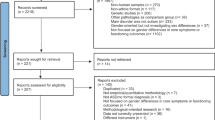The existence of specific behavioral characteristics which can be regarded as autistic spectrum disorder (ASD) in BALB/c mice was detected and confirmed, these consisting of a low level of interaction with socially relevant stimuli and even avoidance of this interaction, along with impairment to the discrimination and particularly the recognition of odors, elevated anxiety, and stereotypical behavior. BALB/c mice provide an experimental model of idiopathic ASD for studies of the pathogenesis of the diseases and its phenotypic manifestations, as well as for evaluating potential substances for the correction of ASD.
Similar content being viewed by others
References
Y. Avraham, E. M. Berry, M. Donskoy, et al., “Beta-carotene as a novel therapy for the treatment of ‘Autistic like behavior’ in animal models of autism,” Behav. Brain Res., 364, 469–479 (2019).
T. M. Kazdoba, P. T. Leach, Yang Mu, et al., “Translational mouse models of autism: advancing toward pharmacological therapeutics,” Curr. Top. Behav. Neurosci., 28, 1–52 (2016).
E. S. Brodkin, “BALB/c mice: Low sociability and other phenotypes that may be relevant to autism,” Behav. Brain Res., 176, 53–65 (2007).
S. S. Moy, J. J. Nadler, A. Perez, et al., “Sociability and preference for social novelty in five inbred strains: an approach to assess autistic-like behavior in mice,” Genes Brain Behav., 3, No. 5, 287–302 (2004).
S. S. Moy, J. J. Nadler, N. B. Young, et al., “Mouse behavioral tasks relevant to autism: phenotypes of 10 inbred strains,” Behav. Brain Res., 176, No. 1, 4–20 (2007).
J. L. Silverman, M. Yang, K. Lord, and J. N. Crawley, “Behavioral phenoty** assay for mouse models of autism,” Nat. Rev. Neurosci., 11, No. 7, 490–502 (2010).
S. S. Moy, J. J. Nadler, M. D. Poe, et al., “Development of a mouse test for repetitive, restricted behaviors: relevance to autism,” Behav. Brain Res., 188, No. 1, 178–194 (2008).
J. N. Crawley, “Mouse behavioral assays relevant to the symptoms of autism,” Brain Pathol., 17, 448–459 (2007).
J. N. Crawley, T. Chen, A. Puri, et al., “Social approach behaviors in oxytocin knockout mice: comparison of two independent lines tested in different laboratory environments,” Neuropeptides, 41, No. 3, 145–163 (2007).
K. K. Chadman, S. Gong, M. L. S. Scattoni, et al., “Minimal aberrant behavioral phenotypes of neuroligin-3 R451C knockin mice,” Autism Res., 1, 147–158 (2008).
F. I. Roullet and J. N. Crawley, “Mouse models of autism: testing hypotheses about molecular mechanisms,” Curr. Top. Behav. Neurosci., 7, 187–212 (2011).
C. R. Shah, C. G. Forsberg, J. Kang, and J. Veenstra-Vanderweele, “Letting a typical mouse judge whether mouse social interactions are atypical,” Autism Res., 6, No. 3, 212–220 (2013).
J. A. Burket, C. M. Young, T. L. Green, et al., “Characterization of gait and olfactory behaviors in the BALB/c mouse model of autism spectrum disorders,” Brain Res. Bull., 122, 29–34 (2016).
F. Muratori, A. Tonacci, L. Billeci, et al., “Olfactory processing in male children with autism: atypical odor threshold and identification,” J. Autism Dev. Disord., 47, No. 10, 3243–3251 (2017).
K. Radyushkin, K. Hammerschmidt, S. Boretius, et al., “Neuroligin-3-deficient mice: model of a monogenic heritable form of autism with an olfactory deficit,” Genes Brain Behav., 8, 416–425 (2009).
E. H. Gregory and D. W. Pfaff, “Development of olfactory-guided behavior in infant rats,” Physiol. Behav., 6, No. 5, 573–576 (1971).
M. Yang and J. N. Crawley, “Simple behavioral assessment of mouse olfaction,” Curr. Protoc. Neurosci., Chapter 8: Unit-8.24 (2009).
B. C. Ryan, N. B. Young, J. N. Crawley, et al., “Social deficits, stereotypy and early emergence of repetitive behavior in the C58/J inbred mouse strain,” Behav. Brain Res., 208, 178–188 (2010).
E. V. Koplik, P. M. Salieva, and A. V. Gorbunova, “The open field test as a prognostic criterion for resistance to emotional stress in Wistar rats,” Zh. Vyssh. Nerv. Deyat., 45, No. 4, 775–781 (1995).
H. Arakawa, “Involvement of serotonin and oxytocin in neural mechanism regulating amicable social signal in male mice: Implication for impaired recognition of amicable cues in BALB/c strain,” Behav. Neurosci., 131, No. 2, 176–191 (2017).
J. Ellegood and J. N. Crawley, “Behavioral and neuroanatomical phenotypes in mouse models of autism,” Neurotherapeutics, 12, 521–533 (2015).
M. A. Yarkova and S. B. Seredenin, “Temporal characteristics of stress-induced decrease in benzodiazepine reception in C57BL/6 and BALB/c mice,” Bull. Exp. Biol. Med., 157, No. 6, 733–735 (2014).
D. S. Melkumyan, T. S. Seredenina, M. A. Yarkova, et al., “Analysis of BDNF in brain structures of inbred mice with different phenotypes of mental and stress reaction,” Bull. Exp. Biol. Med., 140, No. 11, 549–551 (2005).
M. L. Scattoni, A. Martire, G. Cartocci, et al., “Reduced social interaction, behavioural flexibility and BDNF signalling in the BTBR T + tf/J strain, a mouse model of autism,” Behav. Brain Res., 251, 35–40 (2013).
E. L. Grigorenko, Autism Spectrum Disorders. An Introductory Course: Textbook, Praktika, Moscow (2018).
Author information
Authors and Affiliations
Corresponding author
Additional information
Translated from Rossiiskii Fiziologicheskii Zhurnal imeni I. M. Sechenova, Vol. 106, No. 3, pp. 373–383, March, 2020.
Rights and permissions
About this article
Cite this article
Kapitsa, I.G., Ivanova, E.A., Voronina, T.A. et al. Characteristics of the Behavioral Phenotype of BALB/C Mice. Neurosci Behav Physi 51, 93–99 (2021). https://doi.org/10.1007/s11055-020-01043-5
Received:
Revised:
Accepted:
Published:
Issue Date:
DOI: https://doi.org/10.1007/s11055-020-01043-5




